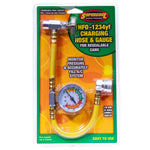You have no items in your shopping cart.

Choosing the right refrigerant can be tough. R-410a refrigerant is a common choice for many. This blog will explain why it's different from others like R-22 or R-134a. Keep reading to find out more.
Key Takeaways
-
R-410A does not harm the ozone layer, unlike R-22, which depletes it.
-
It works under higher pressure than older refrigerants, making it more efficient at cooling.
-
Its Global Warming Potential is higher than some newer options like R-32.
What Sets R-410A Apart From Older Refrigerants Like R-22?
Moving from the introduction to discussing R-410A's unique qualities, we explore its differences from older refrigerants such as R-22. R-410A, also known as Freon 410A, marks a significant shift in cooling technology due to its properties and effects on the environment.
Unlike R-22, which is a hydrochlorofluorocarbon (HCFC), 410a refrigerant does not deplete the ozone layer. This makes it a safer choice for air conditioning systems.
R-22 was widely used for many years but started being phased out in favor of R-410A due to environmental concerns. The transition began in earnest by 2010, with a complete stop on manufacturing new systems using R-22 by 2020.

R-410A offers improved efficiency and environmentally friendlier performance compared to its predecessor.
How Is R-410A Different From R-32, R-134a, and R-22?
R-410A stands out among refrigerants for its unique properties and benefits. Below is a comparison explaining how R-410A differs from R-32, R-134a, and R-22.
|
Refrigerant |
GWP (Global Warming Potential) |
Ozone Depletion Potential (ODP) |
Efficiency |
Operating Pressure |
|
R-410A |
2088 |
0 |
High |
Higher than R-22 and R-134a |
|
R-32 |
675 |
0 |
Similar to R-410A |
Similar to R-410A |
|
R-134a |
1430 |
0 |
Lower than R-410A |
Lower than R-410A |
|
R-22 |
1810 |
0.055 |
Lower than R-410A |
Lower than R-410A |
R-410A is a blend of hydrofluorocarbons (HFCs) used in air conditioning systems. It has a higher efficiency and operates at a higher pressure than its predecessors, R-22 and R-134a. Unlike R-22, R410 A does not deplete the ozone layer, making it more environmentally friendly in terms of ozone impact.
However, its Global Warming Potential (GWP) is higher than R-32, indicating that while R-410A is an improvement over R-22 and R-134a, it still poses challenges for global warming. R-32, on the other hand, offers a lower GWP than R-410A, suggesting a better option for reducing climate impact.
What Are the Performance Differences Between R-410A and Other Refrigerants?
Following the discussion on how R-410A differs from other refrigerants like R-32 and R-134a, it is clear that performance varies significantly among these substances. The efficiency of R-410A stands out.
This refrigerant operates at a higher pressure than older ones like R-22. That means units using 410A can transfer heat better.
For example, R-410A provides more cooling power for its size. It also performs well in high temperatures. In contrast, alternative options may struggle under similar conditions. Comparing refrigerants such as R-134a or even older types like R-22 shows that systems with 410 A refrigerant often run smoother and use less energy overall.
These performance differences make Freon R-410A a strong choice in modern HVAC applications.
Why Is R-410A Considered More Efficient Than R-22?
R-410A is more efficient than R-22 for a few key reasons. First, R-410A operates at a higher pressure. This leads to better heat exchange in the system. It cools spaces faster and uses less energy.
Many units that use refrigerant 410A have improved designs that enhance efficiency even more.

The cooling capacity of R-410A is also higher than that of R-22. This means it can move more heat away from a space in a shorter time. As a result, systems using R-410A can save on energy costs while providing better cooling comfort.
The next section will cover how R-410A compares to other refrigerants like R-32 and R-134a.
Does R-410A Have a Higher Environmental Impact Than Other Refrigerants?
R-410A has a lower ozone depletion potential compared to older refrigerants like R-22. This means it does not harm the ozone layer as much. It has a higher Global Warming Potential (GWP) than some newer options, though.
The GWP of R-410A is around 2,088. This means that if released into the atmosphere, it could trap heat more effectively than carbon dioxide.
Newer refrigerants like R-32 have a lower GWP of about 677. R-134a also has a high GWP at around 1,430. While the environmental impact of R 410 A refrigerant is significant, its efficiency can still make it a popular choice in HVAC systems today.
How Do R-410A’s Operating Pressures Compare to Other Refrigerants?
R-410A has higher operating pressures compared to older refrigerants like R-22. The pressure for R 410A refrigerant is roughly 50% greater than that of R-22. This characteristic makes R-410A more efficient in transferring heat.
It allows air conditioning systems to work better under high temperatures.
In contrast, R-134a has lower pressures than both R-410A and R-22. This difference affects system design and performance. HVAC systems designed for Freon R-410A need thicker components due to its higher pressure levels.
These factors are crucial when choosing a refrigerant for your cooling needs.
Why Can’t R-410A Be Used in Systems Designed for R-22 or R-134a?
R410A refrigerant cannot be used in systems made for R-22 or R-134A. These refrigerants have different chemical properties and pressures. R-22 uses a lower pressure than R-410A. This difference can cause problems if you try to mix them.
Installing R-410A in an R-22 system could damage the equipment. The compressor may fail due to high pressure levels from R-410A. For safety, each refrigerant has a specific system designed just for it.

Using the wrong one can lead to leaks and inefficient cooling, making it important to choose carefully from options like Freon R410A or 410 A refrigerant.
Is R-410A Still a Better Choice Compared to New Low-GWP Alternatives?
R-410A refrigerant is still a solid choice for many air conditioning systems. It has good efficiency and cooling power. New low-GWP alternatives exist, but they often come with trade-offs.
Some of these newer options may not perform as well in extreme heat or cold.
Many users appreciate R-410A for its reliability and effectiveness. It also works well with existing equipment designed for it. While new products aim to reduce environmental impact, R-410A remains a popular option due to its proven performance and availability in the market.
The discussion about refrigerants will continue as technology develops and standards change.
Next, we explore how R-410A’s operating pressures compare to other refrigerants.
Conclusion
R-410A stands out among refrigerants. Its efficiency and high performance make it a popular choice. It operates at higher pressures, which enhances cooling power. Unlike older options like R-22, R-410A is better for the environment.
Choosing R-410A can lead to more energy savings and improved comfort in homes and businesses. For reliable, high-quality R-410A refrigerant, contact us for a trusted source for certified refrigerants and HVAC solutions.
FAQs
1. What is R-410A refrigerant?
R-410A refrigerant, also known as R410 a, is a type of cooling substance used in air conditioning systems and heat pumps.
2. Where can I find R-410A refrigerant for sale?
You can often find R-410A refrigerant for sale at many physical stores that sell HVAC parts or online on various e-commerce platforms.
3. How does the performance of R-410A differ from other types of refrigerants?
The main difference lies in its efficiency and environmental impact compared to older types of refrigerants; it provides better cooling and has less potential to deplete the ozone layer.
4. Can I use other types of refrigerants instead of R-410A in my system?
No, using different kinds may damage your system due to pressure differences; always ensure you're using 410a for sale specifically made for your device.
5. Is certification required to purchase R-410A refrigerant?
Yes, in many regions, you need EPA certification or a similar credential to legally purchase and handle R-410A refrigerant.
 English
English







